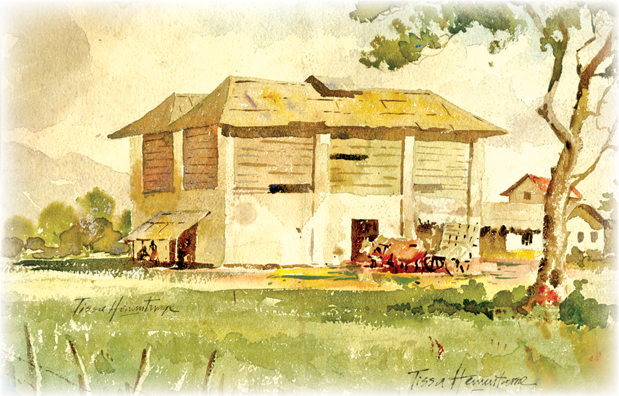Painting buildings
by Tissa Hewavitarane
You cannot avoid buildings for long if you are painting landscapes.
You must learn to make them look convincing and portray the texture of
their materials - stone walls, thatch, tiles, bricks or asbestos sheets.
One of the most common faults with texture is overworking. Some
artists often believe it necessary to indicate every brick in a wall or
to show every tile on a roof. They take hours painstakingly and
needlessly, painting row after row of these.
It is difficult to convince people that suggestion is the key, that
it's only necessary to show details in small portions of the wall or
roof, and the viewers will fit in the rest themselves.
Buildings, boats, trees, fences and rocks all make a fascinating
painting subjects especially when they have grown a little weather
beaten due to the ravages of time and exposure to the elements.
For the watercolour painter, the challenge lies in knowing how to
render a convincing illusion of weathered textures, without overworking
the painting.
|

The painting of a building that looks solid and real |
A lot of beginners tend to shy away from painting buildings because
they think an intricate knowledge of the rules of perspective is
required.
It is not so, in every painting. One can avoid the problems of
complicated perspective by painting a house or a building from a
straight forward viewpoint. But you must learn to make them look
convincing and portray the texture of their materials - stones walls,
thatch houses, tiles or bricks or clapboards.
Basic construction
Let's begin with the basic construction of the building, be it a
house, temple, a church, or a tower. You have to mentally strip it of
all its trappings, decoration and details, and regard it in its simplest
form.
However complex and daunting a building looks at first sight, once
it's broken down into geometric shapes such as cubes and cones with
squares triangles or oblongs attached to them, it's not so daunting.
Combine this thinking with the basic rules of perspective. Once
you've got these simple shapes looking right you can start adding the
details such as windows and doors.
But many beginners seem to want to do these first, like a builder
trying to paper the walls before he's finished the foundations properly.
This is because it's the desire to see how a least one bit of the
painting will look when it's finished, but there's nothing more
disheartening than spending hours on the details only to find that the
basic shape or perspective is wrong and the whole think ruined.
Light and shade
Once having got our basic knowledge in drawings done, the next you
have got to think about is light and shade. The usual mistake here is
that not enough thought is given to the lighting, and the result is that
a building looks flat and anaemic.
It seems fairly obvious that if you can see two sides of a building
one should be darker than the other to give it solidity and depth. This
fact of-ten seems to be forgotten once a painting is in progress.
Try putting a little pencilled cross on the top corner of your
painting to remind you of the direction of the light.
It will also help you to get right angle the shadows are cast. Using
every dark areas on a building would always make it look dramatic and
the use of counter change, as described previously is very important.
Putting a dark tree behind a light roof to throw it up totally or
placing the lightest part of the sky, behind a dark building, are both
effects you should be using in your paintings.
Do not neglect the use of smaller incidental shadows the shadow under
the guttering to show up the edge of the roof, under the window opening
to give them depth; a chimney can be made to stand out by emphasising
its shadow on the roof.
Remember the darker the shadow the brighter the adjacent parts
appear. If the light, at the time you are painting a building, is not
very bright you can use your imagination a bit and intensify the
shadows, as long as their direction is consistent?
And that cross I mentioned earlier will make sure you do not slip up.
The form of an object is revealed by the contrast of light and shade
on its surface, so shadow and cast shadows are powerful element, in
making buildings look three dimensional. Generally, late afternoon is a
good time to paint buildings, when long shadows travel across the
contours of walls and throw surface features into sharp relief.
Favourite subjects
Among favourite buildings painted by watercolour artists are temples,
cathedrals villas massive building house's and churches. These can look
very attractive but they are often let down by overburden with details
and all spontaneity is lost. Not only does this look amateurish, it also
leaves nothing to the viewer's imagination.
Observe the building in my painting which looks more solid and real.
I never wanted to paint modern buildings in the city. They do not arouse
any feeling. I found old and weathered subjects like this building
fascinating, and render their textures more effectively. This building
is not so grand. It's an old storehouse in a far off village.
I have used the traditional techniques of glazing and heavy colours
of burnt sienna, to convey the unauthentic texture of the weather beaten
walls and the wooden shutters in the building. A touch of yellow ochre
with deep olive green gives a pleasing grant appearance.
The kind of paper you choose will play an important part in the
textures you create what I urge you to do is to try them out on spare
pieces of paper first. Remember, a golfer practises strokes before
putting a club to the ball. |

